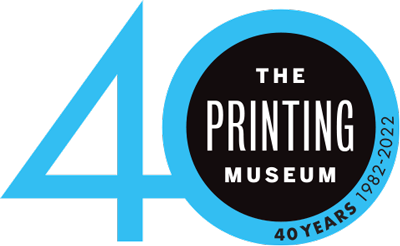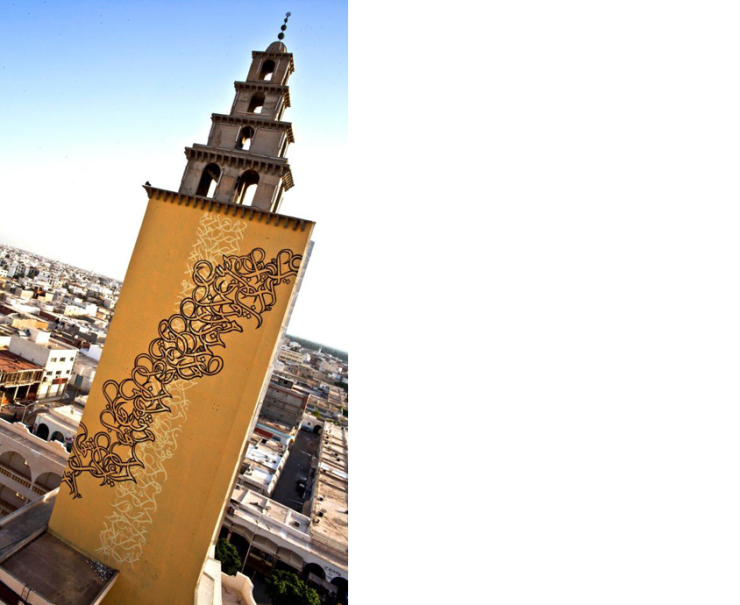Inspired from the 2011 publication “Arabic Graffiti” written by Don Stone Karl and Pascal Zoghbi, the exhibition “Contemporary Arabic Graffiti and Lettering: Photographs of a Visual Revolution,” curated by TPM Curator Keelin Burrows, examines the development and impact of Arabic graffiti over the past decade through 30 contemporary photographs and accompanying didactic panels. The exhibition presents a brief overview of the history and development of traditional Arabic script and calligraphy, providing a framework and context for contemporary calligraphy and graffiti work. However, the exhibition primarily examines how contemporary graffiti artists, mostly from Middle Eastern descent, are reviving and reinterpreting Arabic letter forms into a new graphic style, creating new lettering and typography that is becoming a part of an increasingly globalized design field and practice, as well as part of a larger social and political discourse.
The first theme “Arabic Script and Calligraphy: A Historical Perspective and Beyond” presents the development of the Arabic alphabet composed of 29 letters in script form, and also shows the rise of the two main styles of Arabic calligraphy (Nask and Kufic) in 7th century Iraq. Images of calligraphic artworks, as well as contemporary murals demonstrate the persistence of the calligraphy tradition, but also how it is merging with contemporary technologies, art forms, and practices.
The second theme “The Contemporary Presence of Calligraphy in the Public Sphere” uses documentary photography to demonstrate how calligraphy, often by unknown artists, marks secular spaces. While Arabic calligraphy identifies the exterior walls of shop entrances and facades of trucks, it also commandeers a religious and political presence in the public domain, particularly in Bahrain, Lebanon, and Egypt. Through calligraphic graffiti a dialogue emerges in the public sphere, demonstrating political unrest and raising questions about established ideologies and beliefs.
The third theme “The Rise of International Arabic Graffiti Art” demonstrates how contemporary graffiti artists of Middle Eastern descent are incorporating Arabic calligraphy into large street murals, public light installations and performances. Photographs of works by contemporary artists living in France, Germany, Canada, Jordan, Lebanon, and Indonesia demonstrate how Arabic lettering is being revived and reinterpreted for aesthetic, but also political purposes. Some artists create new letter forms based on traditional script and cursive styles, connecting with historical and cultural identities that have become lost or disenfranchised. Other artists purposefully incorporate Latinized versions of text into their compositions, creating new pictorial forms and meanings for a globalized society.
Once again, language becomes a vehicle for social protest, and the re-imagined letter form becomes not only a means, but also a symbol, for envisioning a brave new world.
Graffiti artists represented in the exhibition include Ammar Abo Bakr, El Seed, Hest1, Julien Breton aka Kaalam, L’Atlas, Monsieur Cana aka Askar, Native & ZenTwO, Sadhu, Sun7 aka Jonas Bournat, Typism and Keos, Yazan, and Zepha aka Vincent Abadie Hafez. Calligraphy artists represented include Malik Anas Al-Rajab, Hassan Massoudy, Mohamed Gaber, and Sameh Ismael.
This exhibition is taking place in conjunction with the FotoFest 2014 Biennial: The Fifteenth International Biennial of Photography and Photo-related Art, March 15 – April 27, 2014, Houston, Texas.
Generous support toward this exhibition was provided by the Houston Endowment, Inc., The Wortham Foundation, Inc., The Brown Foundation, Inc., and Whole Foods Market. The Printing Museum is funded by grants from the City of Houston through Houston Arts Alliance. Photographs for the exhibition were printed at the University of Houston Digital Media Lab.

